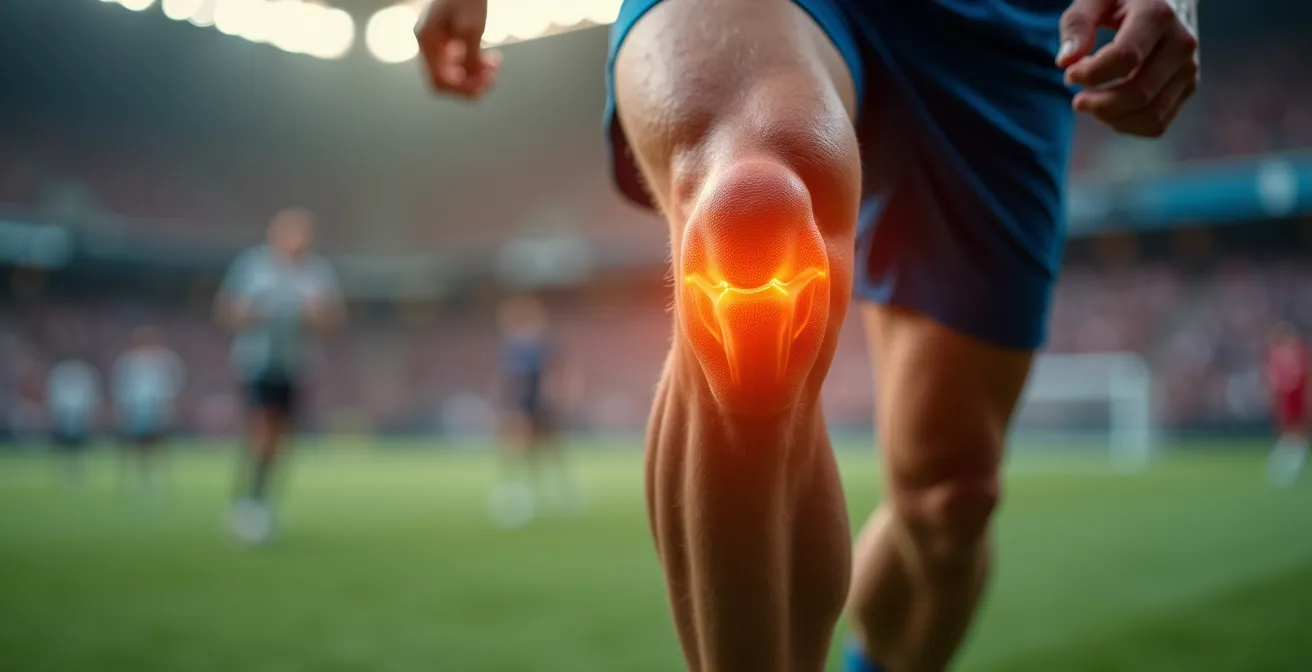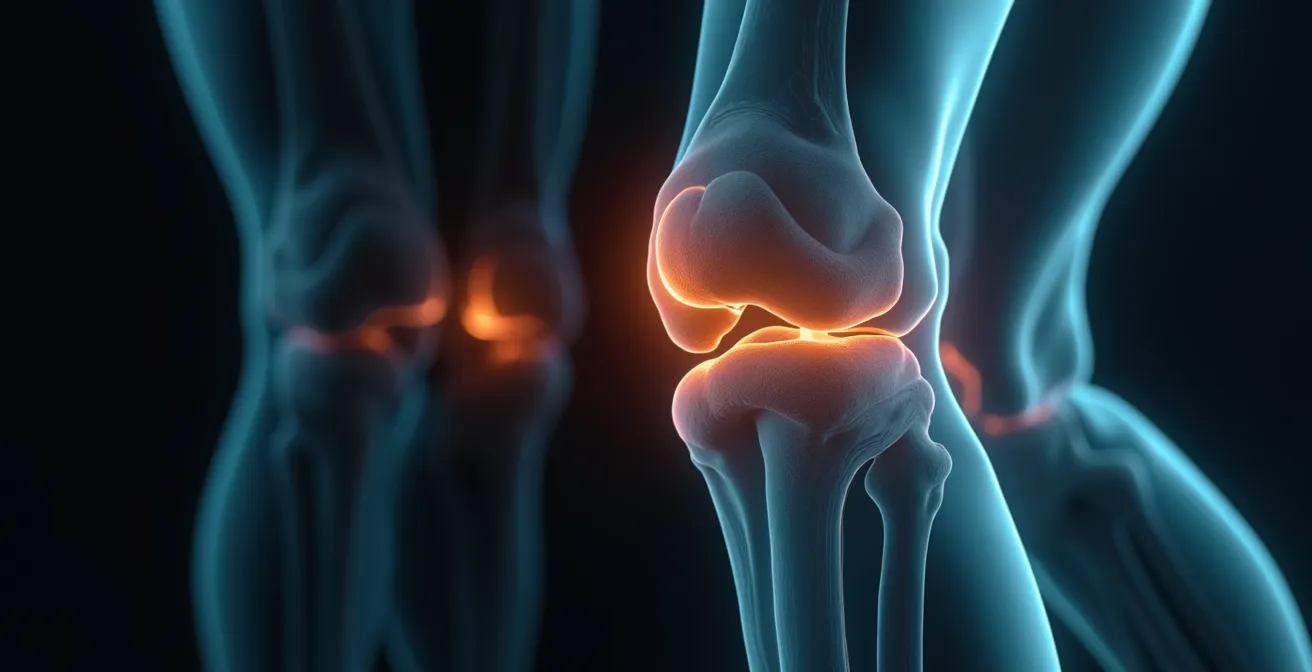
A sudden pivot on the sports field, an awkward landing, or a direct impact—the moment a potential Anterior Cruciate Ligament (ACL) injury occurs is often jarring and confusing. While many associate this common knee injury with a dramatic “pop,” the reality is more nuanced. True recognition goes beyond a single sound; it’s about understanding a constellation of symptoms where the feeling of the knee “giving way” is the most telling sign. Correctly identifying these signals and taking immediate, appropriate action is crucial not just for damage control, but for paving the way toward an accurate diagnosis from an orthopedic specialist like Pr. Etienne Cavaignac and a more effective recovery journey.
Your ACL Injury Response Checklist
- Listen for a pop, but feel for instability: The hallmark sign is a sensation of the knee buckling or giving out.
- Act immediately with R.I.C.E.: Rest, Ice, Compression, and Elevation are your essential first aid steps to manage swelling.
- Avoid critical mistakes: Do not apply heat, bear weight if painful, or try to “walk it off,” as this can worsen the damage.
- Seek professional diagnosis: Self-assessment is unreliable; a medical expert is needed to confirm the injury and guide treatment.
Beyond the ‘Pop’: Recognizing the subtle and obvious signs of an ACL injury
The audible “pop” at the moment of injury is a classic sign of an ACL tear, but its absence doesn’t rule out a significant injury. The most definitive symptom is often a profound sense of knee instability—a feeling that the joint is suddenly untrustworthy, buckling, or “giving way” during simple movements or attempts to bear weight. This sensation is a direct result of the ligament’s compromised ability to stabilize the knee.
What are the three main signs of an ACL tear?
The three key indicators are often a popping sound or sensation, significant knee instability or ‘giving way,’ and rapid swelling.
Pain and swelling can also be misleadingly variable. Some individuals experience immediate, severe pain, while others report milder discomfort. Swelling can be rapid and extensive or it may be delayed, appearing hours after the initial trauma. Differentiating an ACL tear from other common injuries like an MCL sprain involves looking at these patterns together. ACL pain is often felt deep within the knee, whereas MCL pain is typically localized to the inner side of the joint.
People usually experience a popping sensation and knee instability with an ACL tear, but pain severity varies.
– Cleveland Clinic, ACL Tear & Injury: Symptoms & Recovery
To better distinguish between these common knee injuries, understanding the typical symptom profiles is key. The following table compares the hallmark signs associated with an ACL tear, an MCL injury, and a general knee sprain.
| Symptom | ACL Tear | MCL Injury | Knee Sprain |
|---|---|---|---|
| Pop Sound | Often Present | Rare | Rare |
| Knee Instability | Common | Possible | Unlikely |
| Swelling Timing | Rapid or Delayed | Rapid | Varies |
| Pain Location | Deep Inside Knee | Inner Knee Line | Generalized |
A systematic self-check immediately following a suspected injury can help in communicating effectively with medical professionals. Use this checklist to assess the primary indicators.
Checklist for Early Recognition of ACL Injury Signs
- Listen for an audible pop or feel it at injury moment.
- Notice any immediate swelling or delayed swelling patterns.
- Assess if the knee feels unstable or gives way during movements.
- Distinguish location and type of pain compared to other knee injuries.
Immediate actions: The critical first steps after suspected knee trauma
Following a suspected knee injury, the actions taken within the first 24-48 hours are critical for managing pain, minimizing swelling, and preventing further damage. The universally recommended first-aid approach is the R.I.C.E. protocol: Rest, Ice, Compression, and Elevation. Proper implementation is key to its effectiveness. Rest means avoiding all weight-bearing activities immediately. Ice should be applied for 10-20 minutes every 2-3 hours, using a barrier like a thin towel to protect the skin. Compression with an elastic bandage helps control swelling, and elevating the leg above heart level uses gravity to reduce fluid buildup.
It is crucial to know when to seek immediate medical care. Signs like severe, uncontrollable pain, a visible deformity in the knee, or a complete inability to move the leg warrant a trip to the emergency room. If the symptoms are less severe, scheduling an appointment with a doctor for the following day is appropriate. However, certain actions should be strictly avoided. Do not apply heat, as it can increase swelling. Avoid consuming alcohol or massaging the injured area, as these can also promote bleeding and swelling. Finally, do not attempt to force movement or “test” the knee’s limits. If possible, immobilizing the joint can help prevent accidental movements that could worsen the injury.

The primary goal of these initial steps is to create the best possible conditions for a thorough and accurate medical examination. Reducing swelling not only alleviates pain but also allows a specialist to perform physical tests more effectively to determine the extent of the damage.
Seek emergency care if there is severe uncontrollable pain or complete inability to move the leg.
– Douglas Bartels, M.D., Mayo Clinic Health System
This organized approach to first aid ensures that the injury is managed safely from the very beginning. Here is a clear breakdown of the R.I.C.E. protocol for easy reference.
R.I.C.E. Protocol details for knee injury
- Rest: Limit weight-bearing as much as possible immediately after injury.
- Ice: Apply ice packs for 10 to 20 minutes every 2 to 3 hours.
- Compression: Use an elastic compression wrap to control swelling, ensure it’s snug but not too tight.
- Elevation: Keep the injured knee elevated above heart level to reduce swelling.
Navigating the diagnostic pathway: What to anticipate with medical experts
Once you seek professional medical help, the diagnostic process will begin with a thorough physical examination. A specialist will assess the knee for swelling, tenderness, and range of motion, but most importantly, for stability. They will perform specific manual tests, such as the Lachman test and the pivot shift test, which are designed to reveal the integrity of the ACL by assessing how much the tibia (shinbone) moves in relation to the femur (thighbone). While these maneuvers can cause some discomfort, they are essential for an accurate diagnosis. Understanding the typical symptoms of an acute injury will help you describe your experience clearly.
Effective use of Lachman and pivot shift tests combined with MRI to confirm ACL tears
A prospective study on 133 patients showed a combination of physical tests and MRI accurately diagnosed ACL tears, allowing better treatment stratification. This highlights how a multi-faceted diagnostic approach, blending hands-on examination with advanced imaging, leads to the most reliable conclusions for patient care.
To support the physical findings and get a clearer picture of the damage, imaging tests are typically ordered. An X-ray is often the first step to rule out any bone fractures. The gold standard for confirming an ACL tear, however, is a Magnetic Resonance Imaging (MRI) scan. An MRI provides detailed images of the knee’s soft tissues, allowing the doctor to see the ligament tear, determine its severity, and check for any associated injuries, such as damage to the meniscus or other ligaments.
The table below outlines the purpose and general accuracy of the common diagnostic tests you may encounter. Sensitivity refers to a test’s ability to correctly identify patients with the condition, while specificity refers to its ability to correctly identify patients without the condition.
| Test | Purpose | Sensitivity | Specificity |
|---|---|---|---|
| Lachman Test | Assess forward tibial translation to detect ACL tear | 85% | 94% |
| Pivot Shift Test | Detect rotational instability | 24% | 98% |
| Anterior Drawer | Assess anterior tibial displacement | 92% | 91% |
| MRI | Visualize ligament tear severity and associated injuries | High | High |
Communicating effectively with your healthcare provider is vital. Being prepared for your appointment can help ensure all your concerns are addressed and your doctor has the information they need.
Preparing for your ACL diagnostic appointment
- Document the details of your injury event and symptoms onset.
- Communicate any feelings of instability or pain during specific movements.
- Be ready to undergo physical tests that may cause discomfort.
- Ask your provider about the necessity of MRI or other imaging.
Key Takeaways
- Instability, or the knee “giving way,” is a more reliable sign of an ACL tear than the famous “pop.”
- Immediate application of the R.I.C.E. protocol is crucial for managing swelling and preparing for an accurate diagnosis.
- Avoid common mistakes like applying heat or bearing weight, which can significantly worsen the initial knee trauma.
- A definitive diagnosis requires a professional medical assessment, often involving physical tests and an MRI scan.
Debunking ACL injury myths: Clarifying misconceptions for better response
Misconceptions surrounding ACL injuries are common and can lead to delayed or improper responses. One of the most prevalent myths is that an inability to bear weight is the only sign of a severe tear. In reality, many individuals with complete ACL tears can still walk, albeit with a feeling of instability. Another widespread misconception is that the absence of a loud “pop” or severe, immediate pain means a serious injury hasn’t occurred. However, symptoms vary widely, and up to 25% of ACL tears occur without the classic ‘pop’ sound or sudden inability to bear weight.
As highlighted in a myth-busting guide by JMS Hospital, the presentation of symptoms can differ greatly among individuals. While different mechanisms of injury, like a direct impact versus a twisting motion, might present slightly different symptom profiles, the core indicators often overlap. The most critical takeaway is that self-diagnosis is unreliable and potentially dangerous. Only a professional medical assessment can accurately diagnose the injury and determine the appropriate treatment plan. Taking these steps is the best way to Protect your overall health and ensure a proper recovery.

By understanding the facts and dispelling these myths, you can react more appropriately to a potential knee injury, prioritizing professional evaluation over assumptions. This clear-headed approach is fundamental to achieving a successful outcome.
Misconceptions and facts on ACL injuries
- Myth: Only athletes sustain ACL tears – Fact: Anyone can injure their ACL.
- Myth: Surgery is always needed – Fact: Some tears can be managed conservatively.
- Myth: Bracing completely prevents ACL tears – Fact: Braces provide support but don’t guarantee prevention.
- Always seek professional assessment instead of self-diagnosis.
Frequently asked questions on knee injury
Can you walk on a torn ACL?
Yes, many people can walk after tearing their ACL. However, the knee will likely feel unstable or may buckle, especially during twisting movements. Continuing to walk on it without a diagnosis can risk further damage to other structures in the knee, like the meniscus.
Does an ACL tear always require surgery?
Not always. The decision for surgery depends on several factors, including the patient’s age, activity level, and the degree of knee instability. Less active individuals or those with partial tears may be able to manage their injury with physical therapy and lifestyle modifications.
How long does it take for an ACL tear to heal?
An ACL ligament does not heal on its own due to its poor blood supply. Recovery time varies greatly depending on the treatment. After reconstructive surgery, it typically takes six to nine months of rehabilitation before an individual can safely return to sports and high-impact activities.
What is the difference between a knee sprain and an ACL tear?
A knee sprain is a general term for a stretched or torn ligament. An ACL tear is a specific, often more severe, type of knee sprain involving the Anterior Cruciate Ligament. While a mild sprain might involve stretching, a tear indicates a partial or complete rupture of the ligament fibers, usually resulting in significant instability.